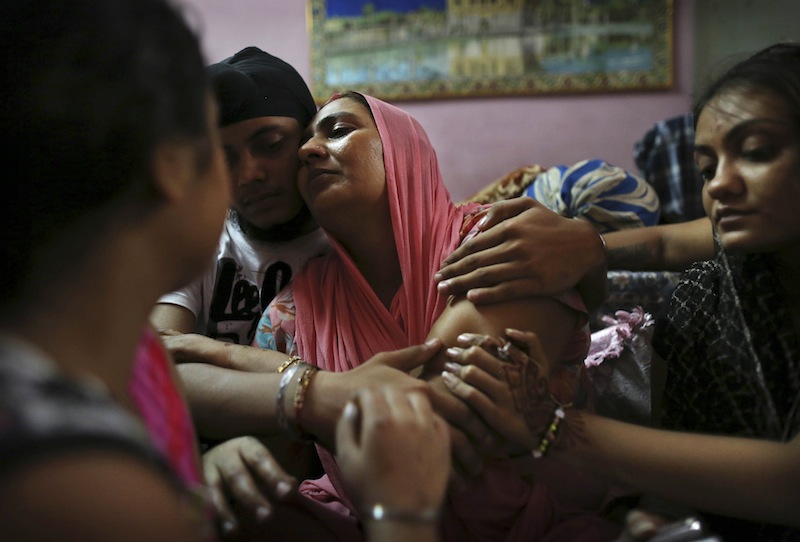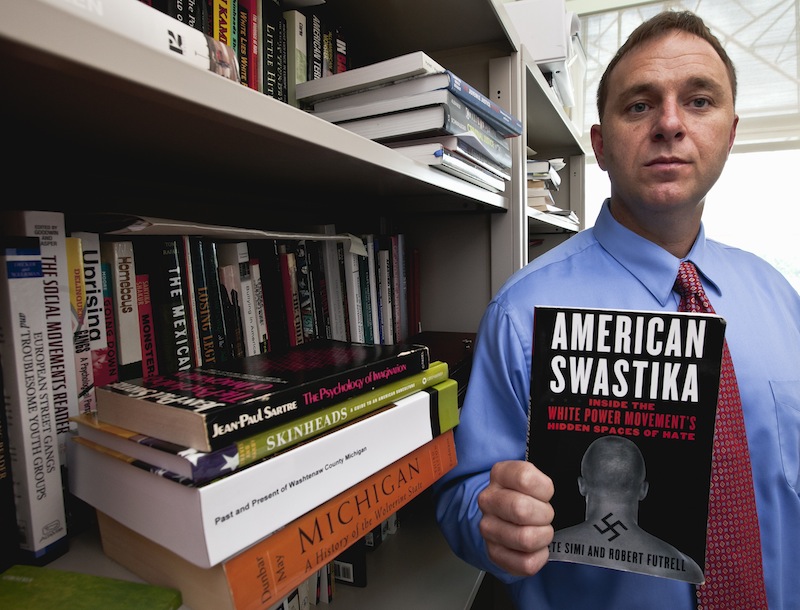MILWAUKEE — When they aren’t ranting in Internet forums, many of the nation’s white supremacists seek a louder outlet for their extreme views: thunderous, thrashing heavy metal or punk music with lyrics that call for a race war.
Wade Michael Page, the gunman who killed six people at a Sikh temple in Wisconsin before being killed by police, was deeply involved in the “hate rock” scene – a shadowy world of hundreds of performers in the U.S. and Europe, most of them playing metal or hardcore punk. Some also play country, folk and other genres.
Largely unknown to most Americans, this musical subculture is an integral part of neo-Nazi circles, offering a way for like-minded followers to connect with each other and socialize, recruit new members and raise money for their cause.
“It really was a good political weapon for the agenda,” said Jason Stevens, who once fronted a white-power band called Intimidation One in Portland, Ore.
Page once played guitar and bass with Intimidation One, as well as in bands called Definite Hate and End Apathy.
Stevens, who turned his back on white supremacy in 2004 and now owns a small business, said he was shocked to hear that a friend he remembered as “mellow and quiet” had committed such a heinous crime.
The two last talked on the phone in 2010, and Stevens said Page was “his usual laid-back self.” At the time, Stevens said, he had a job at a Colorado metalworking shop.
Stevens said money raised by his band’s tours and record sales was often funneled to legal defense funds for white supremacists charged with federal crimes, including Randy Weaver, whose 1992 standoff with federal agents in Ruby Ridge, Idaho, left a U.S. marshal and two Weaver family members dead.
The music “brings in more revenue than virtually anything else,” said Brian Levin, a criminal justice professor at California State University at San Bernardino, who has consulted for the FBI and other federal agencies on white supremacists.
The National Alliance, a prominent white-power organization, sometimes cleared $1 million a year in profit from music, books and magazines, video games and other supremacy products, Levin said.
One of the most influential white-supremacist record labels, Resistance Records, often sold hate-rock albums for $14.88 — “14” represented the 14 words in a popular skinhead mantra, and “8” pointed to “H” as the eighth letter of the alphabet.
“Doubling it up stood for ‘Heil Hitler,'” said Todd Blodgett, a former Reagan White House aide who once had an ownership stake in Resistance Records but later informed on white supremacist groups for the FBI.
Senior leaders of the groups see hate rock as the most effective way to recruit young followers, said Blodgett, who said he never held racist views but got wrapped up in far-right organizations without knowing the full implications of their beliefs.
The band now viewed as the pioneer of hate rock was called Skrewdriver, hailing from Britain’s skinhead scene in the late 1970s and pioneering a genre called “Oi,” which sounds similar to punk bands of the period such as the Sex Pistols.
The genre quickly spread to the U.S. and mushroomed in the early 1980s. In more recent years, the Internet enabled much wider distribution of the music, with many of its record labels run by a single person with a post-office box.
Not all the music is abrasive. Current performers featured on the Resistance Records website include Saga, a Swedish singer who sings about how “this is the way my race ends” in a lilting voice that recalls Sarah McLachlan. Some white supremacists also play folk, which they have rebranded as “volk” music, using the German word for “people.”
Still, aggressive punk and metal are hate rock’s main outlets. That was what Page played while fronting End Apathy. Heidi Beirich of the Southern Poverty Law Center tried to decipher Page’s lyrics, but found them mostly unintelligible beyond choruses of “Sieg Heil.”
On Monday, Label 56, the Baltimore-based outfit that released End Apathy’s music, removed from its website all images and products related to the band, and denounced Page’s actions. An email inquiry did not get an immediate response.
Hate rock concerts and festivals are commonly held on private land. Smaller shows are held at clubs or bars, with the groups often concealing their ideology from venue owners.
“You’ll see a lot of machismo, a lot of aggression,” said Pete Simi, a University of Nebraska-Omaha social scientist who’s done field research into hate groups and attended shows.
“It’s a very hyper-masculine space. The men will have their T-shirts off, and most are heavily tattooed.” The gatherings often include “rough dancing that looks like a brawl,” and fights are common. Stabbings are not unusual.
Simi also knew Page, having spent time with him during research in southern California in 2001 to 2003. The two then fell out of touch.
Asked if Milwaukee police tracked hate metal groups, spokeswoman Anne Schwartz said via email that authorities “are aware of the threats by groups who are contributors to acts of domestic terrorism.”
Matthew Chandler, spokesman for the Department of Homeland Security, declined to say if the agency specifically tracked hate rock groups but said it’s focused “on preventing violence that is motivated by extreme ideological beliefs.”
Levin said it can be difficult for law enforcement to focus specifically on certain individuals well-known in hate-rock circles unless there’s evidence they’ve committed some type of crime.
Mark Pitcavage, an investigator of right-wing groups for the Anti-Defamation League in New York City, said acts of right-wing extremism are at the highest level since the mid-1990s, around the time of the Oklahoma City bombing. He credited federal authorities for staying on top of the threats, but said it often takes incidents such as the temple attack to get the public’s attention.
Stevens recalled the hundreds of hours he spent with Page in vans and cars as they traveled to gigs around the U.S. and Europe.
“You get intimate with people. You get to know their secrets and stuff,” Stevens said. “This was a guy, I never even seen him get in a fight — even when riots broke out at the shows. When I heard what happened, I felt sick.”
Send questions/comments to the editors.




